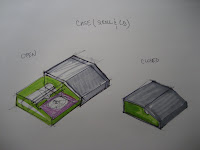Tokyo the Impermanent Capital
Richie states that Westerns believe that Tokyo is chaotic and primitive. You can see why, I have already stated some reasons above. I was shocked to see that Richie also had the same reactions as I did. Walking down the street of my neighborhood, I feel like I was walking through a movie set. The streets are too clean, the homes and yards are too perfect. Shopping in Leforte makes me feel like I'm walking past shadow boxes or dioramas.
Another one of my favorite concepts is this:
...these extremely contemporary looking structures are like the tents of the nomads-with the difference that the Japanese move not in space, but time.
Woa, Richie...this one is heavy, but well understood. Take a random block in minato-ku and you can see the journey from wooden home with tile roof, to space age looking condos.
Richie calls into question the sophistication of the western city. Does it make sense to place shopping districts in suburbs and provide little or no public transportation? This is so true! I've wondered about this logic myself.
The Real Disney Land
I was shocked to know that there was a Disneyland just outside of Tokyo. I've always wanted to go to Disneyland but being from New York, it was so far from home. My first reaction was to hop on train and shoot out there before I have second thoughts. Too late! I thought to myself , "why would I need to go to Disneyland? I'm in Tokyo. There's alot more to see here! Experiencing this city an opportunity of a lifetime."
Now that I think about it, it's not surprising to me that Japan imported Disneyland. They've imported bits of western and asian culture and this is no different. Also I read that the Japanese embrace childhood and immortalize it.
Richie makes a great point that Japan values to concept of "microcosm." You can see it in architecture (blend of east and west in street block), the microchip, and the bonzi tree - existing in it's miniature world.
Oh! and the home of Kitsch. I always kinda thought that about Japan. Blame it on Godzilla! The Harajuku girls dress kitschy- at least in my opinion. But I think that Japan gets the liberty to be the "kingdom of kitsch." Like we have mentioned before, Japan (or at least Tokyo) is this strange blend of eastern and western cultures. Finding the right balance is tough, and there is potential to go overboard.
the City Home
The title of this article is very appropriate. When you consider the Japanese view of a house (place where you sleep) and the busy schedule of the salaryman, one can begin to see how many Japanese adopt a second or third "home."
Space is definitely a luxury. I just noticed that some houses have "stackable parking" so you can park a car and then raise the car. Then park another car underneath that car. wow. Space is limited. But in it's absence , the Japanese have devised some wonderful ways to cope.
I read this article a while ago and it's been bothering ever since. The article was written in 1980, but I wonder if most women are still chained to the home? Or are there more career women now then ever before? I thought about this on the train the other day when I was sitting across from a bunch of school girls. "what's the point of them getting an education if they're just gonna stay home?"
Walking home from the train station I realized how much I appreciate my neighborhood. I love passing by outdoor markets and Mom&Pop shops. I noticed that I also have developed a routine, get off the train, pop into the grocery store. I can see how people can develop friendships with their neighbors and become "loyal" to their local market. Richie says it's been this way since the days of Edo. I wish my hometown was like this.
Walking in Tokyo
I remember reading this article just last week and thinking to myself, "Wow, I can't wait to experience all of this!" And here I am. Donald Richie is right, there is so much too see!
When I was first let loose in this city, I struggled to understand the logic. There were no street names. narrow roads tangled around buildings. People and cars occupied the same space. The signage is a mass of unidentifiable visual confusion. At first glace , it was complete chaos.
I also marvelled at the difference from building to building. This is perhaps one of my favorite facts that Richie mentions. He explains unlike our western perspective-BUILD IT TO LAST, the Japanese seem to "build for the season," They don't need to dwell on the past, but look to the future. that is why they constantly tear down old buildings to make way for something new.
Richie closes this article by comparing old Edo to Tokyo. He illustrates that even though Tokyo shops now display new fangled gadgets and more, people stroll through the streets the same way they did many years ago. On Sundays people take time to look at shops and enjoy the sights.
Tokyo Style
Ha. This title was misleading. I was expecting Harajuku girls! Tokyo style is all about contrast. The east and west. The traditional and the modern. It's obvious that Tokyo is modern, and probably the MOST modern city in the world, im not gonna elaborate. Yet I do enjoy the mod, modern, modular section. Traditionally Japanese style was modular-tami mats sliding shoji doors. It's great to see that carried through into modern design-prefab housing etc.
I was inspired when I read the section about how the Japanese city is always in transition. I wish American cities weren't afraid to knock down old buildings. It almost seems stupid that some of them still exists, and maybe only for the purpose of explaining our history. Take your average townhouse in Philadelphia. Probably built in the 1800's. Tall and narrow, maybe a slightly larger footprint than Japanese homes. If only were willing to part with just one, we might find that in the same amount of space, we could have an modern functional structure for living. What good are 14ft ceilings anyway? That's not luxury. It's exuberant! And while we are at it, lets do something about those narrow alleys too small for cars- just big enough for carriages. Just because Ben Franklin didn't drive an SUV, doesn't mean we can't adapt the city to meet the demands of today's lifestyle.
Signs and Symbols
I heart semiotics. I walk through the streets of Tokyo not having a clue what most of the signage means but I appreciate that. It's actually one of the reason's why I chose to come here. I want to see how well Japanese symbols, pictograms, and signage can communicate a message to someone who doesn't speak the language. If symbols can do that, you know they are truly intuitive and successful. Richie explains how foreigners begin analyze and understand the signage. Grouping signs by color, shape, and location. He also mentions how traditionally the Japanese intended signage to not only be function but beautiful. So even advertisements become public art. Even audio cues are created to be pleasant. I noticed this tradition is alive and well every time I exit the train, or turn on the rice cooker. Where Americans insert a "BEEP" to indicate your popcorn is done, the Japanese have substituted a sound for a melody. And why not? Everyone likes music.


























.jpg)




















